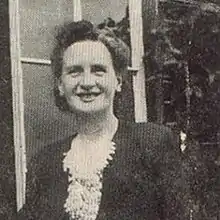Ruby Ferguson
Ruby Constance Annie Ferguson, née Ashby (28 July 1899[1] – 11 November 1966), was an English writer of popular fiction, including children's literature, romances and mysteries as R. C. Ashby and Ruby Ferguson. She is best known today for her novel Lady Rose and Mrs. Memmary and her Jill books, a series of Pullein-Thompsonesque pony books for children and young adults.
Ruby Constance Annie Ashby Ferguson | |
|---|---|
 | |
| Born | Ruby Constance Annie Ashby 28 July 1899 |
| Died | 11 November 1966 (aged 67) |
| Nationality | British |
| Other names | R. C. Ashby, Ruby Ferguson |
| Occupation | Novelist |
| Notable work | Lady Rose and Mrs. Memmary |
| Spouse | Samuel Ferguson |
Life and career

Ruby Constance Annie Ashby was born in Hebden Bridge and raised in Reeth, North Yorkshire. Her parents were Ann Elizabeth, (born Spencer) and the Reverend David Ashby, a Wesleyan minister.[2] Ferguson later became a lay officer of the Methodist church. She received her education at Bradford Girls Grammar School and then at St Hilda's College at the University of Oxford, where she read English from 1919 to 1922, gaining a 3rd class BA[2] and, a few years later, the Oxford MA.
She then moved to Manchester and took a job as a secretary, supplementing her income by writing a regular column for the British Weekly. She reviewed books for the publisher Hodder and Stoughton.[2] Her writing career began in earnest when she submitted some detective stories for a weekly competition in the Manchester Evening News. Her first full-length novel, The Moorland Man, appeared in 1926 published by Hodder and Stoughton.[2] She continued writing novels and stories under the name "R.C. Ashby" until the mid-1930s.
In 1929 she assisted the Liberal party candidate William C. Mallison at the West Derbyshire constituency.[2]
On 1 March 1934, she married Samuel Ferguson, a widower and electrial engineer[2] with two sons at the Water Lane Methodist Church, in Wilmslow. Three years later, she published Lady Rose and Mrs. Memmary as Ruby Ferguson, a romantic novel that became her greatest success, which was republished in 2004 by Persephone Books.[3] After its original publication, The Queen Mother is reported to have enjoyed the book so much that she invited Ruby Ferguson to dinner at Buckingham Palace. The new edition also received favourable notices and it was one of the "Books of the Year" by The Spectator.
Between 1949 and 1962 she gained great popularity with the "Jill" books for her step-grandchildren, Libs, Sallie, and Pip. Her last book in 1967, Children at the Shop, is a fictionalised memoir of her childhood.[4]
Aside from the Jill series, most of Ferguson's books are long out of print.
The Jill books
The Jill books are a series of nine children's novels about young equestrienne Jill Crewe and her adventures with her two ponies, Black Boy and Rapide. In recent editions, small changes were made to the to make the books more accessible. The series takes the protagonist from the age of twelve to fifteen, from a pony novice to a prize-winning rider.[5]
In the first book in the series, Jill's Gymkhana, Jill's father has recently died, and she moves with her mother to a small Pool Cottage near the fictional village of Chatton. Her mother hopes to support them both as a children's author (similarly to E. Nesbit's classic The Railway Children). Jill is at first a social outcast in "horsy" Chatton because she doesn't own a pony and can't ride. When her mother's stories finally begin to sell for £52, however, the first thing she buys is "Black Boy" pony for £12 for her daughter. With hard work and the expert assistance of Martin Lowe, a wheelchair-using former Royal Air Force pilot, Jill becomes a star of Chatton equitation.
Jill is grateful for her mother's success; however, as she says repeatedly throughout the series, she "can't get on" with her mother's books at all, finding them impossibly sweet and whimsical (possibly a veiled criticism of the works of Enid Blyton). In contrast, Ferguson's Jill is an active, independent and witty character who defies post-war expectations for English girls by scorning ladylike pursuits, treating boys her own age as equals, and working hard to achieve her goals. This makes Ferguson's writing outstanding not only in the pony stories genre, but in children's literature generally.[6]
Extracts
- Jill has just discovered she must spend the summer holidays away from her pony Black Boy while her mother does a book tour in the United States. Source: A Stable for Jill, Chapter 1.
I did my level best to look on the bright side, only I honestly couldn't find one to look on. There was a book of Mummy's called Barbie Bright Side about a girl who had both her legs cut off in a motor smash and got such a name for looking on the bright side that practically everybody in the town used to come to her and ask her to find a bright side for them too, and she always did. "Gosh!" I said aloud. "If Barbie could find a Bright Side in this she ought to get the V.C."
- Jill and her friends are having tea with Susan Pyke, a snooty, superior sort of girl with wealthy parents. Susan rides very well and is a perennial rival for Jill. Here, Susan's mother waxes nostalgic about her own horse-riding past. Source: Jill's Gymkhana, Chapter 16.
'When I was a child,' said Mrs Pyke, 'I was the youngest rider to hounds in the county. I remember the M.F.H. once lifted me on to my pony himself, and there I sat in my little habit with my long fair curls hanging down to my waist. Children had the loveliest hair in those days.' Personally I thought (a) it was impossible to picture Mrs Pyke as a child at all, and (b) that curls down to your waist must have looked pretty awful all waving in the breeze like floating cork-screws.... I mean, there are always plaits.
- Jill is finishing up a great day at Chatton Show, the equestrian event of the year in her part of the world. Her best friend, Ann Derry, has done quite well too. Source: Jill's Gymkhana, Chapter 18.
'Nice work,' said Martin as we came up, and we both glowed a bit.
'Mine was just luck,' said Ann, 'but Jill's riding like a cyclops.'
'You mean, if she had two eyes she'd be riding like a centaur,' said Martin, and we all laughed as we munched our sandwiches and put away a lot of ice cream. Then we went to have a look at the ponies and make a fuss of them for doing so well, and we found them resting quietly in the shade of the trees and making soft little nickering noises of pleasure when they heard us speaking to them, and saw the handfuls of oats we held out to them.
Mrs. Darcy, a local riding instructor, has had to go to London, and Jill along with some of her friends, is looking after the riding school in Mrs. Darcy's absence. These responsibilities extend to looking after Blue Smoke, Mrs. Darcy's own gorgeous hunter worth 500 guineas. However, Blue Smoke gets desperately ill in the middle of the night, and Jill is called up to the riding school to help get the vet, along with Wendy. Source: Jill Has Two Ponies, Chapter 11
'Well, you girls clear out,' said the vet, cheerfully, 'and let me have a look. Go and make me a cup of tea. I've been sitting up with a cow for hours.'
We thought it very heartless of the vet to want tea, but we went into the house and made him a cup. We didn't make any for ourselves, it would have choked us. Every time I caught Wendy's eye she gave a gulp, and every time Wendy caught my eye I gave a gulp. We did nothing but gulp at each other. I set off down the yard with the vet's cup of tea and slopped it all over into the saucer. Then suddenly I saw the vet before me. The heartless man was grinning all over his face.
'She's just been playing you up,' he said. A touch of a toothache, that's all, but you know what these thoroughbreds are like, the least touch of pain and they act as if they were dying.'
List of works
Single works
- The Moorland Man (1926)
- The Tale of Rowan Christie (1927)
- Beauty Bewitched (1928)
- Death at Tiptoe (1931)
- Miss Graham's Guest ("The Methodist", No. 90, June 1932)
- Plot Against a Widow (1932)
- He Arrived at Dusk (1933)
- One Way Traffic (1933)
- Out Went the Taper (1934)
Single works
- Lady Rose and Mrs Memmary (1937) (Republished in 2004 by Persephone Books)
- The Moment of Truth (1944)
- Our Dreaming Done (1946)
- Winter's Grace (1948)
- Turn Again Home (1951)
- Apricot Sky (1952)
- A Paintbox for Pauline (1953)
- The Leopard's Coast (1954)
- For Every Favour (1956)
- Doves in My Fig-tree (1957)
- The Cousins of Colonel Ivy (1959)
- The Wakeful Guest (1962)
- A Woman With a Secret (1965)
- Children at the Shop: The Charming Autobiography of Childhood (1967)
- The Queen's Book of the Red Cross. With a message from Her Majesty the Queen and contributions by fifty British authors and artists. In aid of the Lord Mayor of London's Fund for the Red Cross and the Order of St. John of Jerusalem (1939) (contributor)
The Jill series
- Jill's Gymkhana—sometimes sold with A Stable for Jill. (1949)
- A Stable for Jill (1951)
- Jill has Two Ponies (1952)
- Jill Enjoys her Ponies (1954) (later republished as Jill and the Runaway)
- Jill's Riding Club (1956)
- Rosettes for Jill (1957)
- Jill and the Perfect Pony (1959)
- Pony Jobs for Jill (1960) (later republished as Challenges for Jill)
- Jill's Pony Trek (1962)
References
- 1939 England and Wales Register
- Horrell, Georgina; Jaques, Zoe (14 September 2023), "Ferguson [née Ashby], Ruby Constance Annie (1899–1966), novelist and children's author", Oxford Dictionary of National Biography, Oxford University Press, doi:10.1093/odnb/9780198614128.013.107939, ISBN 978-0-19-861412-8, retrieved 2 October 2023
- Ferguson, Ruby (2004). Lady Rose and Mrs. Memmary. Persephone Books. ISBN 978-1-903155-43-1.
- Ferguson, Ruby (1967). Children at the Shop. Hodder & Stoughton.
- Jones, Eleanor (13 November 2021). "Black Boy and Rapide ride again! Jill books to be republished – plus two follow-up stories". Horse & Hound. Retrieved 2 October 2023.
- Liz Thiel. "The Dark Horse: Ruby Ferguson and the Jill Pony Stories." The Lion and the Unicorn 26, 2002, pp. 112–122.Full Text. Accessible through libraries subscribing to Project MUSE.
External links
- A biographical note from Persephone Books
- Lady Rose and Mrs Memmary at Persephone Books
- A review of Lady Rose by Nicholas Clee of The Guardian.
- More biographical information from Hilary Clare; plot summaries and more from a site specialising in pony books.
- A useful article about collecting old books, featuring the author's pony books, amongst others.